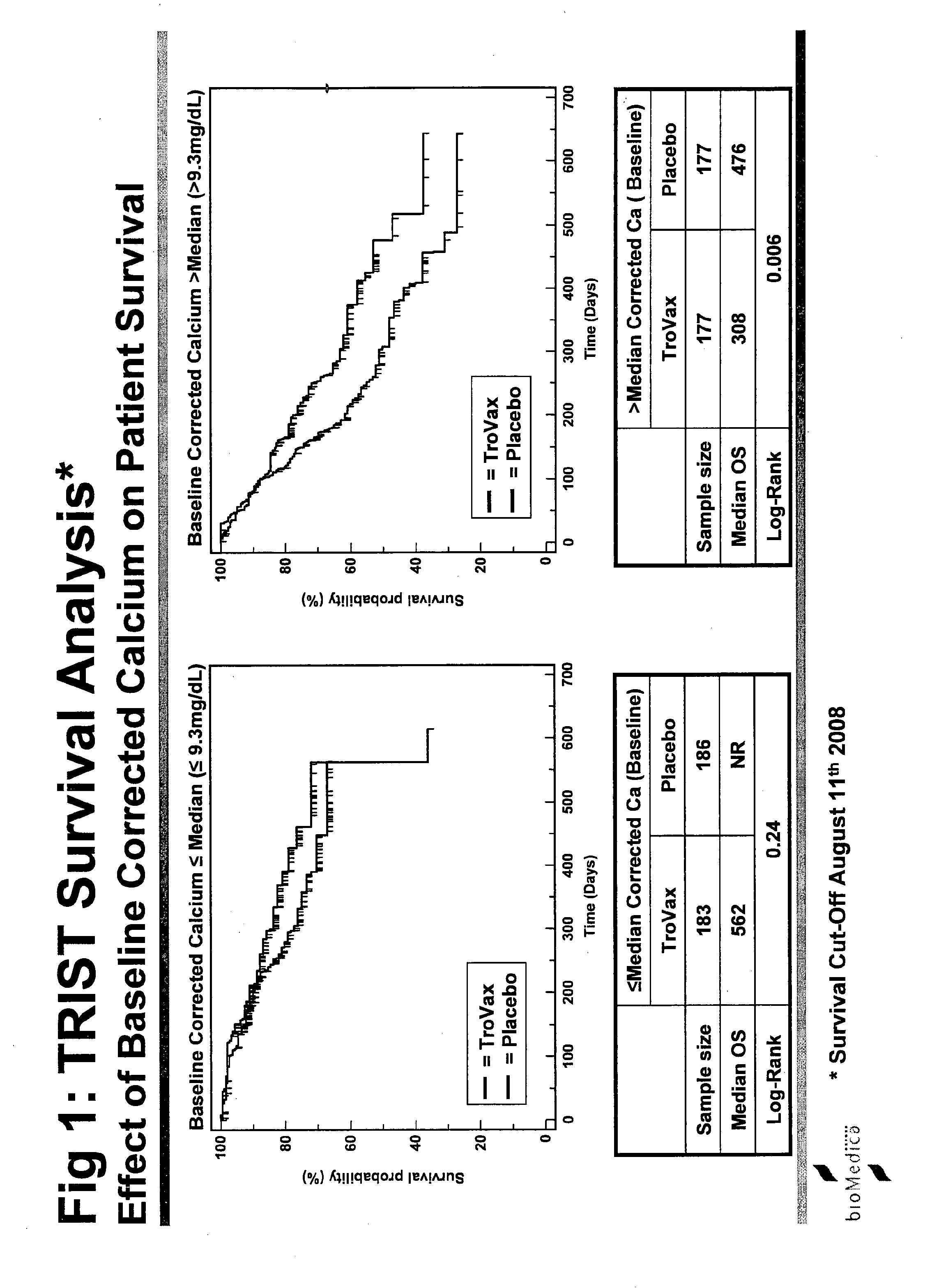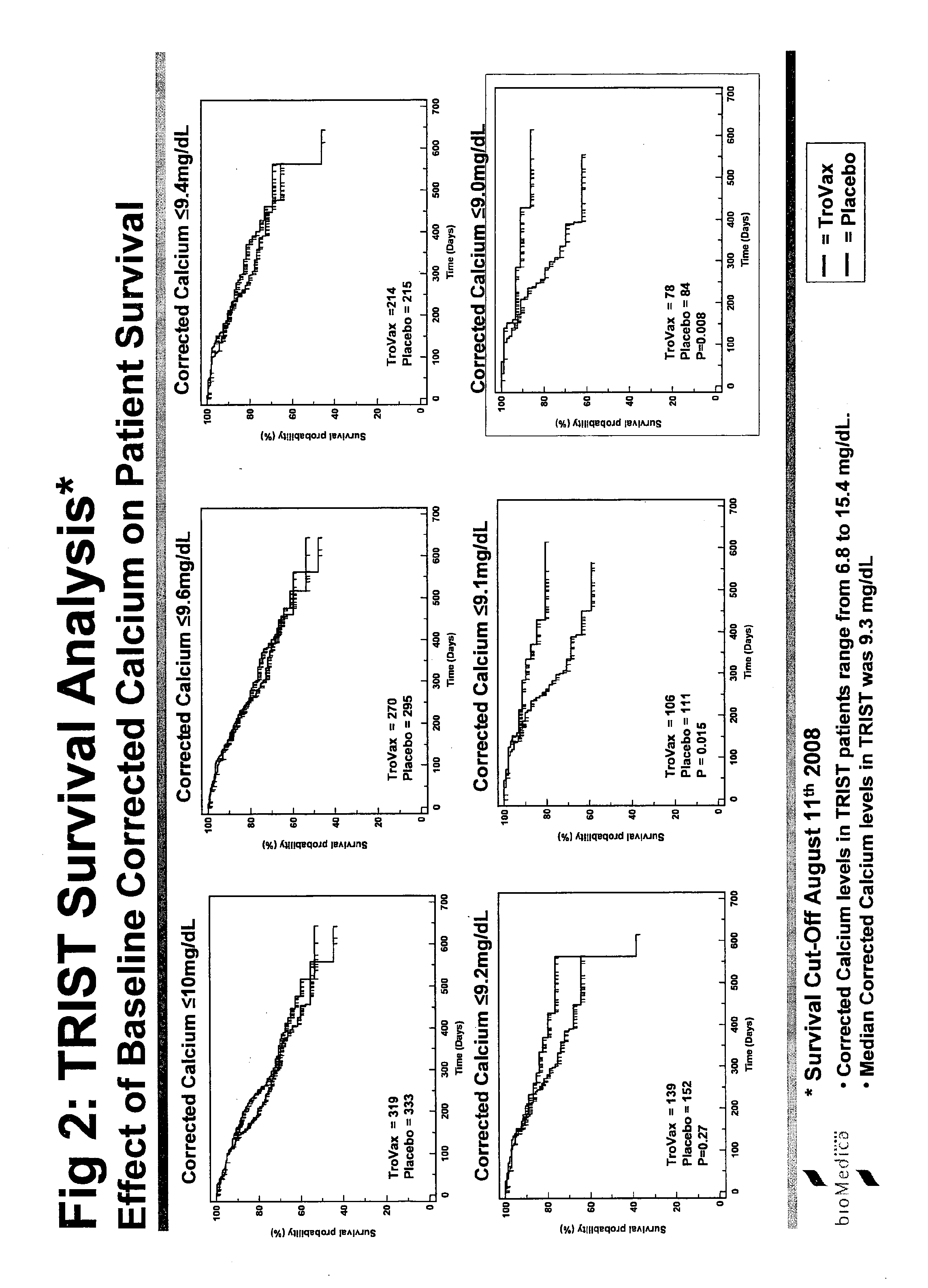Factors
a cancer and factor technology, applied in the field of factors, can solve the problems of not teaching a skilled worker what, tumor cells are notoriously poor immunogens, etc., and achieve the effects of reducing affecting the efficacy of treatment versus placebo, and reducing the effect of treatmen
- Summary
- Abstract
- Description
- Claims
- Application Information
AI Technical Summary
Benefits of technology
Problems solved by technology
Method used
Image
Examples
example 1
Study Details—TRIST
[0240]The study was termed TRIST: TroVax® Renal Immunotherapy Survival Trial. An international Phase III, randomized, double blind, placebo controlled, parallel group study to investigate whether TroVax® added to first-line standard of care therapy, prolongs the survival of patients with locally advanced or metastatic renal clear cell adenocarcinoma.
[0241]The primary purpose of this trial is to demonstrate the effect of TroVax® on survival in patients with locally advanced or metastatic renal clear cell adenocarcinomas. Clear cell adenocarcinomas of the kidney uniformly express 5T4 at high concentrations (80-90% of tumors examined) and are therefore an obvious candidate for treatment with a 5T4 vaccine.
[0242]Reported median survival times for this indication vary between studies but are generally in the range of 6 to 18 months depending on patient's status at entry and to a lesser extent on treatment. Novel forms of treatment are urgently needed.
[0243]This study w...
example 2
Phase II Survival Analysis (CRC) Patients—Effect of Factors on Patient Survival
[0626]The results of the trials described in the following papers were analysed:
Vaccination of colorectal cancer patients with modified vaccinia Ankara delivering the tumor antigen 5T4 (TroVax) induces immune responses which correlate with disease control: a phase I / II trial. Harrop R, Connolly N, Redchenko I, Valle J, Saunders M, Ryan M G, Myers K A, Drury N, Kingsman S M, Hawkins R E, Carroll M W. Clin Cancer Res. 2006 Jun. 1; 12(11 Pt 1):3416-24.
[0627]An MVA-based vaccine targeting the oncofetal antigen 5T4 in patients undergoing surgical resection of colorectal cancer liver metastases. Elkord E, Dangoor A, Drury N L, Harrop R, Burt D J, Drijfhout J W, Hamer C,
Andrews D, Naylor S, Sherlock D, Hawkins R E, Stern P L. J Immunother. 2008 November-December; 31(9):820-9.
[0628]Vaccination of colorectal cancer patients with TroVax given alongside chemotherapy (5-fluorouracil, leukovorin and irinotecan) is saf...
example 3
[0642]From previous analysis reported above, four variables (platelets, monocytes, white blood cells (WBC) and haemoglobin) were selected to be examined in more detail. In this analysis, the change in treatment effect across subsets of patients defined by baseline values of platelets, monocytes, WBC and haemoglobin was examined.
[0643]Objective & Methods
[0644]Objective
[0645]To estimate and plot the adjusted hazard ratio across changing baseline levels of platelets, monocytes, white blood cells and haemoglobin.
[0646]Methods
[0647]Subsets of patient variables were created using cut points defined by the 10th, 25th, 50th, 75th and 90th percentile for each of the four factors. For each subset, the adjusted hazard ratio (which adjusted for imbalances in prognostic factors between the two treatment arms) was estimated using a Cox proportional hazards model. As there were a limited number of patients and events in the subsets, it was not possible to include all known prognos...
PUM
| Property | Measurement | Unit |
|---|---|---|
| shape | aaaaa | aaaaa |
| concentration | aaaaa | aaaaa |
| nucleic acid | aaaaa | aaaaa |
Abstract
Description
Claims
Application Information
 Login to View More
Login to View More - R&D
- Intellectual Property
- Life Sciences
- Materials
- Tech Scout
- Unparalleled Data Quality
- Higher Quality Content
- 60% Fewer Hallucinations
Browse by: Latest US Patents, China's latest patents, Technical Efficacy Thesaurus, Application Domain, Technology Topic, Popular Technical Reports.
© 2025 PatSnap. All rights reserved.Legal|Privacy policy|Modern Slavery Act Transparency Statement|Sitemap|About US| Contact US: help@patsnap.com



